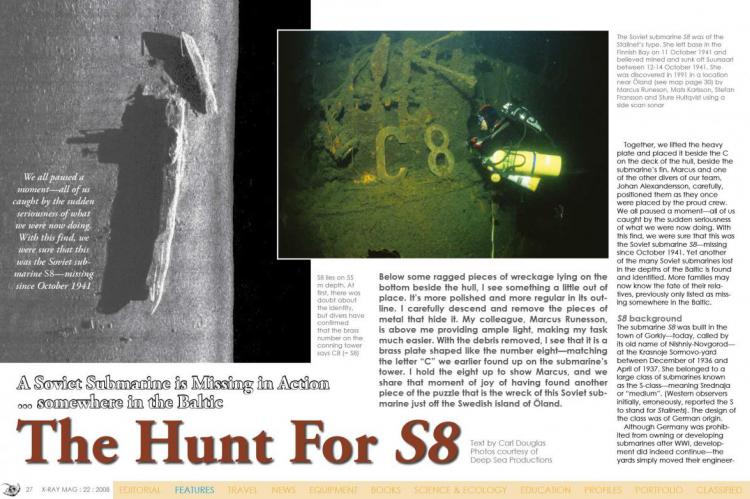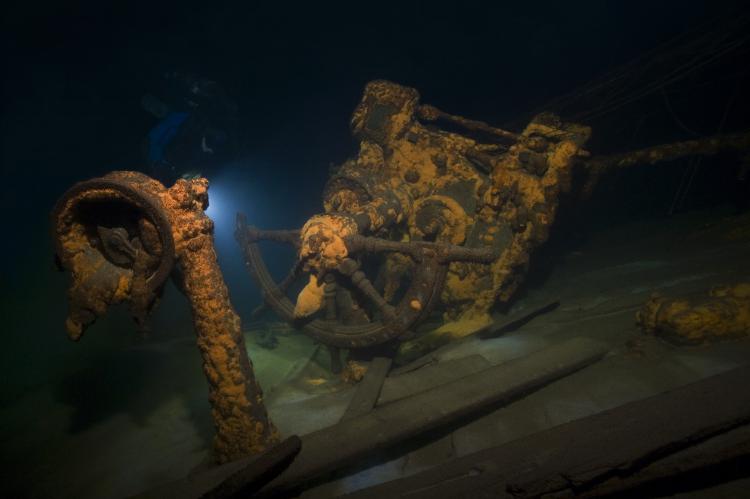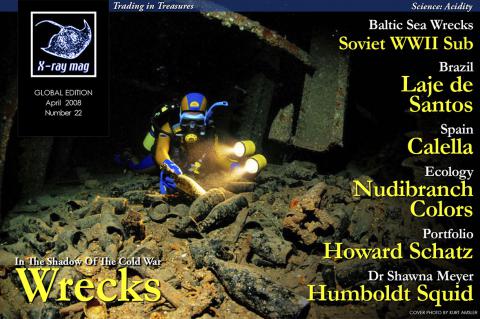The Hunt For S8
Below some ragged pieces of wreckage lying on the bottom beside the hull, I see something a little out of place. It’s more polished and more regular in its outline. I carefully descend and remove the pieces of metal that hide it. My colleague, Marcus Runesson, is above me providing ample light, making my task much easier. With the debris removed, I see that it is a brass plate shaped like the number eight—matching the letter “C” we earlier found up on the submarine’s tower.
Tags & Taxonomy
Together, we lifted the heavy plate and placed it beside the C on the deck of the hull, beside the submarine’s fin. Marcus and one of the other divers of our team, Johan Alexandersson, carefully, positioned them as they once were placed by the proud crew. We all paused a moment—all of us caught by the sudden seriousness of what we were now doing. With this find, we were sure that this was the Soviet submarine S8—missing since October 1941. Yet another of the many Soviet submarines lost in the depths of the Baltic is found and identified. More families may now know the fate of their relatives, previously only listed as missing somewhere in the Baltic.
S8 background
The submarine S8 was built in the town of Gorkiy—today, called by its old name of Nishniy-Novgorod—at the Krasnoje Sormovo-yard between December of 1936 and April of 1937. She belonged to a large class of submarines known as the S-class—meaning Srednaja or “medium”. (Western observers initially, erroneously, reported the S to stand for Stalinets). The design of the class was of German origin.
Although Germany was prohibited from owning or developing submarines after WWI, development did indeed continue—the yards simply moved their engineering departments to Holland. Several countries, in addition to the Soviet Union, purchased designs from the joint firm, among them Sweden, Finland, Spain and Holland. The German engineers further refined the design, eventually resulting in the long-distance Type IX class for the German Navy.
The S8 was commissioned into the Soviet Navy’s Baltic Fleet on June 30, 1940. The first year was spent working up the crew and preparing for the war that loomed.
When Nazi-Germany attacked on June 22, 1941, the S8 was based at the large submarine base at Ust-Dvinsk—today’s Daugavgriva—just north of Riga, Latvia. Along with seven other submarines, she belonged to the 1st Division of the 1st Brigade of the Baltic Fleet. Shortly after the outbreak of war, the S8 was sent to sea along with those submarines that were serviceable.
As the Nazis advanced, the Soviet submarines were forced back, first to Tallinn in Estonia and finally to the bases around Leningrad—today’s St. Petersburg— at the end of August. It was not until early October 1941 that the S8 could be dispatched for a full combat patrol, together with three other boats of the smaller SHCH-class.
The force was tasked with interdicting the shipping carrying iron-ore from neutral Sweden to Nazi-Germany in the area between Norrköping and the island of Öland.
(...)
Download the full article ⬇︎

Originally published
X-Ray Mag #22
This issue is packed with stories on wrecks, nudibranchs, sea turtles and sharks. We visit dive destinations at Leje de Santos in Brazil and the picturesque village of Calella on the wild coast of Spain. Arnold Weisz investigates effects of the treasure trade. Learn how carbon emissions is changing the acidity of the seas and the effects on sealife. South African underwater photographer, Fiona Ayerst, reports on the tragic loss of eight Tiger sharks, three of them poached in protected waters. Andrey Bizyukin translates an interview with explorer Anatoly Sagalevich who touched bottom at the North Pole. Cedric Verdier discusses diver safety and rescue in very remote areas. Get a report on Moscow's Golden Dolphin dive show, an inside perspective of IAHD's education for disable divers, Shawna Meyer's close encounter with Humboldt squid, and tips from Kurt Amsler on shooting wrecks. We interview fine art and commercial photographer, Howard Schatz, about his latest book, H2O.



